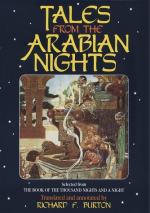[FN#232] M. Hermann Zotenberg lately informed me that “Khudadad and his Brothers” is to be found in a Turkish Ms., “Al-Faraj ba’d al-Shiddah”—Joy after Annoy—in the Bibliotheque Nationale of Paris. But that work is a mere derivation from the Persian “Hazar o yek Roz” for which see my vol. x. p.441. The name Khudadad is common to most Eastern peoples, the Sansk. Devadatta, the Gr. {Greek} and Dorotheus; the Lat. Deodatus, the Ital. Diodato, and Span. Diosdado, the French Dieu-donne, and the Arab.-Persic Alladad, Divdad and Khudabaksh. Khuda is the mod. Pers. form of the old Khudai=sovereign, king, as in Mah-i-Khudai=the sovereign moon, Kam-Khudai=master of his passions, etc.
[FN#233] Lit. Homes (or habitations) of Bakr (see vol. v. 66), by the Turks pronounced “Diyar-i-Bekir.” It is the most famous of the four provinces into which Mesopotamia (Heb. Naharaym, Arab. Al-Jazirah) is divided by the Arabs; viz: Diyar Bakr (capital Amidah); Diyar Modhar (cap. Rakkah or Aracta); Diyar Rabi’ah (cap. Nisibis) and Diyar al-Jazirah or Al-Jazirah (cap. Mosul). As regards the “King of Harran,” all these ancient cities were at some time the capitals of independent chiefs who styled themselves royalties.
[FN#234] The Heb. Charran, the Carrhae of the classics where, according to the Moslems, Abraham was born, while the Jews and Christians make him emigrate thither from “Ur (hod. Mughayr) of the Chaldees.” Hence his Arab. title “Ibrahim al-Harrani.” My late friend Dr. Beke had a marvellous theory that this venerable historic Harran was identical with a miserable village to the east of Damascus because the Fellahs call it Harran al-’Awamid—of the Columns—from some Graeco-Roman remnants of a paltry provincial temple. See “Jacob’s Flight,” etc., London, Longmans, 1865.
[FN#235] Pirozah=turquoise, is the Persian, Firuzah and Firuzakh (De Sacy, Chrest. ii. 84) the Arab. forms. The stone is a favourite in the East where, as amongst the Russians (who affect to despise the Eastern origin of their blood to which they owe so much of its peculiar merit), it is supposed to act talisman against wounds and death in battle; and the Persians, who hold it to be a guard against the Evil Eye, are fond of inscribing “turquoise of the old rock” with one or more of the “Holy Names.” Of these talismans a modern Spiritualist asks, “Are rings and charms and amulets magnetic, to use an analogue for what we cannot understand, and has the immemorial belief in the power of relics a natural not to say a scientific basis?”
[FN#236] Samaria is a well-known name amongst Moslems, who call the city Shamrin and Shamrun. It was built, according to Ibn Batrik, upon Mount Samir by Amri who gave it the first name; and the Tarikh Samiri, by Aba al-Fath Abu al-Hasan, is a detailed account of its garbled annals. As Nablus (Neapolis of Herod., also called by him Sebaste) it is now familiar to the Cookite.




